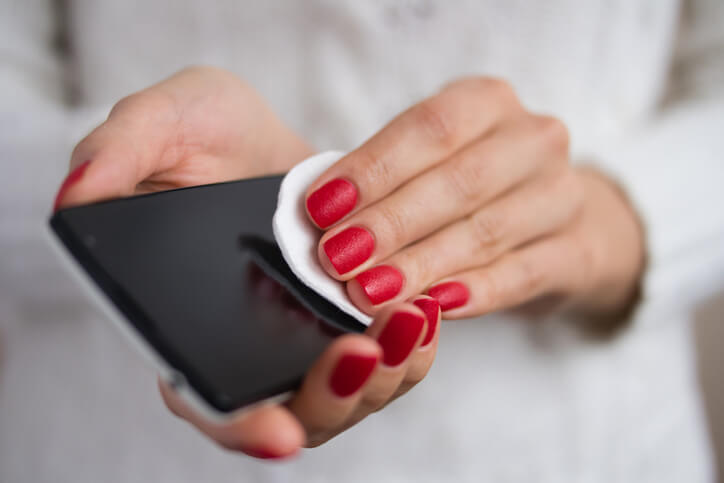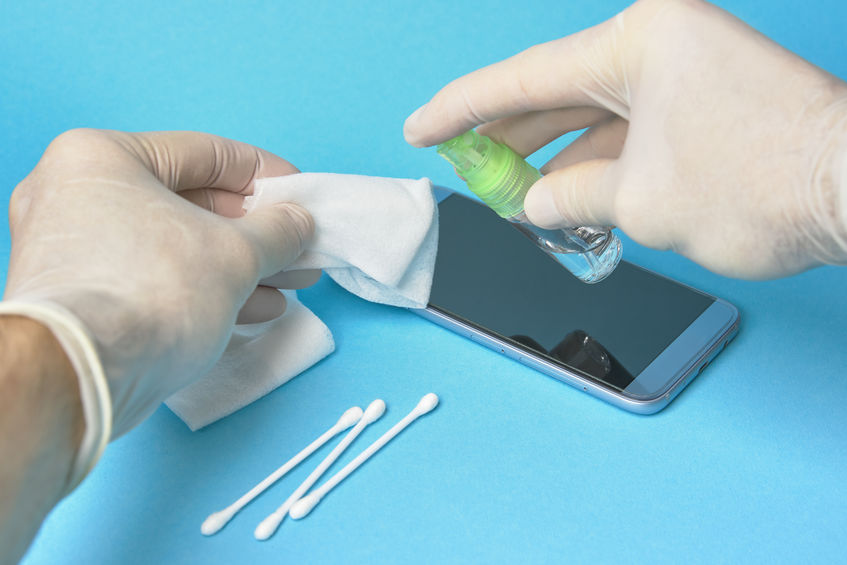- Clean Home
- Clean
- How To Clean Your Phone
How To Clean Your Phone
How to clean your phone, and why it is essential. It's enough to make a germaphobe gag: Scientists at the University of Arizona found that cell phones have, on average, ten times more bacteria than a toilet seat.
It's easy to understand why - we're practically joined at the hip (or ear or arm) with our cell phones. Our smartphones keep us running.
They have become the remote control for our lives—from staying in touch with family and friends to setting reminders and even waking up in the morning.
Where we go, they go, too. And let's be honest here: we occasionally hang out at unsavory places (think public restrooms). As a result, our cell phones get pretty gross.
If you have yet to clean touchscreens as much as you should, it could be because the methods sometimes seem to be a moving target. Here's what you need to know about how to clean your phone and other touchscreens at home.
Safe Screen Cleaning
PUT AWAY THE WINDEX. Your first instinct upon encountering a smudged screen might be to grab the glass cleaner and go to town.
Resist that urge at all costs. Touch-sensitive screens have an oleophobic coating to resist smudging and fingerprints.
Chemicals like ammonia, found in most glass cleaners, are adept at removing surface grease and grime and eradicating the protective coating on electronic devices.
WIPES ARE OKAY. For anyone with an iPhone, you'll be interested to know that early into the pandemic, in March 2020, Apple updated its cleaning guidelines to encourage using isopropyl alcohol to kill bacteria, viruses, and other pathogenic microbes on its products.
You may recall that before the update, rubbing alcohol was a big no-no. Big companies like Apple changed their tune on disinfecting screens during the pandemic.
While Apple used to advise against using bleach-based cleaners and similar agents on its products' screens, it's now urging customers to use them to be safer.
The revised cleaning guidelines now endorse using a 70 percent isopropyl wipe or Clorox Disinfecting Wipes to gently wipe the hard, nonporous electronic surfaces, such as the display and keyboard and other exterior surfaces.Further recommendations, according to Cupertino: "Don't use bleach. Avoid getting moisture in any opening, don't spray cleaners directly on the surface, and don't submerge in any cleaning agents."
How to Clean Your Phone Screen Germs
Using the latest information, follow these steps to clean your phone, tablet, and other touchscreen devices safely using an easy-to-make, inexpensive electronics cleaning and sanitizing spray.
Our own hands are the biggest culprit when it comes to the filth that gets on our phones.
According to a recent study, we check our phones every 12 minutes - or 80 times a day. We allow pathogens, including Streptococcus, MRSA, and E. coli, to move from our fingers to our phones.
Once settled in, these microscopic menaces can live for hours on a warm surface like your phone or tablet. To keep the nasties away, clean your phone regularly. Here's how.
How to Clean Your Phone
A lightly dampened cloth is often enough to clean your phone of surface scratches and fingerprints.
However, to remove all the microscopic menaces, a two-step approach is required: cleaning and disinfecting. Yes, cleaning and disinfecting are separate processes.
Cleaning physically removes surface dust, dirt, smudges, and many germs, but not all. Disinfecting kills those left behind.
1. Power off, Wipe off
Start by powering off your device. Not only is it easier to see dirt and smudges when the screen is off, but it's safer, too.
Also, remove the device's case. It's better to clean and disinfect them separately, so you don't miss any crevices the germs are calling home.
Thoroughly yet gently wipe the screen and surfaces with a soft, dry (or very lightly water-dampened) lint-free cloth or microfiber cloth for electronics to remove smudges, dust, and debris.Avoid scrubbing vigorously, as this might cause damage. Be sure to clean both the front and back of the device and the case.
2. Clear Crevices
Now we're getting down to the real dirty business. First, use a toothbrush or other soft-bristled brush to clean your phone of dust and other debris in the crevices around your phone's screen.
To remove dirt in speaker holes and the cord connection area, use one of your vacuum cleaner's small attachments to suck away the offending debris. (Don't use compressed air to clean your phone because you could inadvertently drive the dirt further into the device holes.)
Finally, clean small areas around the camera lens, attachment ports, or buttons of surface gunk by gently working a dry cotton swab or wooden toothpick around those areas to loosen and remove any buildup.
3. Finish with Disinfecting
You can easily make a cheap and effective cleaning and disinfecting spray to clean your phone and your home's other electronic devices.
As an added cleaning bonus, the distilled water in the recipe keeps mineral deposits off your electronic screens.
ELECTRONICS SCREEN CLEANING SOLUTION:
- A spray bottle
- 1/2 cup distilled water
- 1/2 cup isopropyl alcohol (rubbing alcohol)
- Microfiber cleaning cloth or other clean lint-free cloth
Pour the rubbing alcohol and distilled water into a spray bottle and shake gently to combine.
The cleaning solution may be stored in the spray bottle for up to 2 months. Make sure to label and date the spray bottle so you'll know what's inside and when to use it.
Spray the cleaning solution lightly onto a clean microfiber cloth and apply it to the screen until it is visibly wet but not dripping. (Never spray cleaners directly on your electronic devices.)
Wait 5 minutes for the alcohol to disinfect the area, then wipe dry with a clean microfiber cloth. Remember to treat the case, too!
After you clean your phone, allow it to air dry completely—or at least 15 minutes—before replacing the case and powering up.
.
- Clean Home
- Clean
- How To Clean Your Phone








